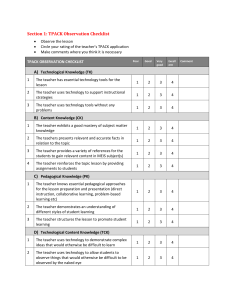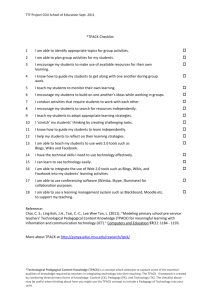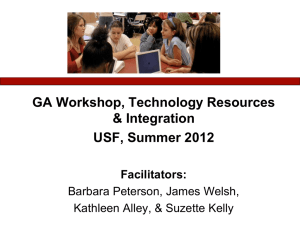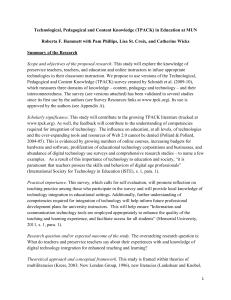The uptake of technology in education: way forward? Joke Voogt
advertisement
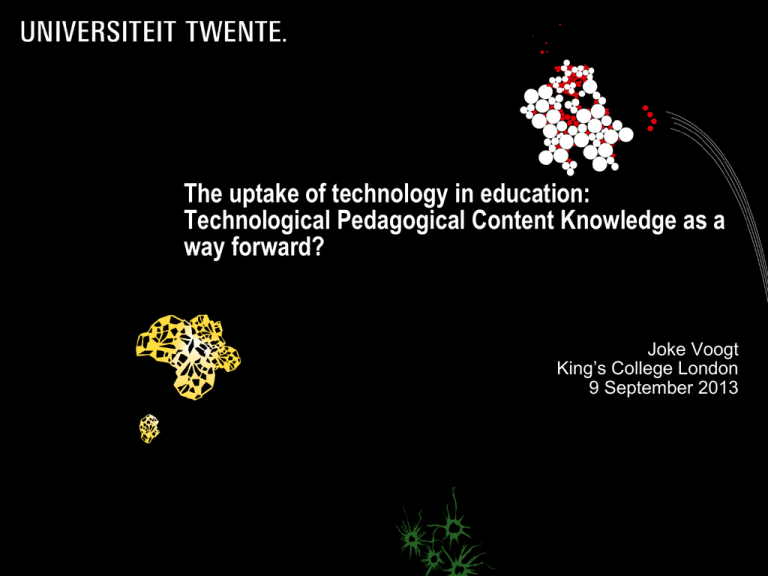
The uptake of technology in education: Technological Pedagogical Content Knowledge as a way forward? Joke Voogt King’s College London 9 September 2013 In this presentation Teachers’uptake of technology What is Technological Pedagogical Content Knowledge (TPACK)? TPACK as a conceptual model As a framework for identifying the knowledge base for teaching with technology As a guide during the design of technology-enhanced lessons and programmes TPACK as assessment model? Discussion The professional identity of teachers Teaching takes place in a complex and dynamic environment Teachers are able to integrate very different knowledge domains: Subject matter Pedagogy They need to know how students can learn a difficult concept or procedure And Knowledge about how ICT can foster teaching and learning The uptake of technology Despite experiences in the last decades: Teachers have unsufficient knowledge and experience with the use of ICT for teaching Many teachers got their degree when ICT was not as ubiquitous as it is now Many teachers find themselves unprepared for using ICT in teaching Many teachers do not see the added value of ICT for teaching and learning What is TPACK? Koehler & Mishra (2006): TPCK emphasizes the interactions between content, pedagogy and technology. A conceptual framework describing the knowledge base for teachers to effectively teach with technology Do we need to extend Shulman’s notion of PCT to TPACK. The core of good teaching; building on teachers’ professional identity “At the heart of good teaching with technology are three core components: content, pedagogy, and technology, plus the relationships among and between them.” (Koehler & Mishra, 2006) Technological Knowledge • Being able to operate specific ICT applications • being able to learn how to use specific ICT applications and its affordances •A functional understanding of ICT Technological Pedagogical Knowledge: How pedagogy is changing because of ICT Technological Content Knowledge: How subject matter content is changing because of ICT TPACK Technological Pedagogical Content Knowledge: The knowledge and skills yeachers’need to be able to integrate subject matter content, pedagogy and ICT Important: To be able to play with the model Ignoring the complexity can lead to too easy solutions or failures. Context counts Why studying TPACK? We became fascinated by the attractiveness of the model the acceptance of the model by teachers but also by the complexity of the model (and what’s behind it) We worked on Survey for pre-service teachers Professional development for pre- and in-service teachers (with our PhD students) Literature review (JCAL, 2012) Discussions/debates/presentations TPACK as a conceptual framework As a guide during lesson As a guide for programme development Two examples Example 1 A serious game for vocabulary learning Example 2 TPACK as a conceptual model for the development of a programme of study Example 1: A serious game for vocabulary learning Pedagogical underpinning Verhallen & Verhallen Prepare Give meaning By the teacher in a lesson: Lesson plans Feedback on learners’ results Consolidate Check Repeat With the game on the computer: Minigames –endless practice, direct feedback, incentives/ gameplay, Identification with ‘ídols’ Verhallen & Verhallen Voorbewerken Semantiseren Consolideren Controleren Herhaling door de docent in de klas Minigames (eindeloos oefenen – ook thuis), directe feedback, beloning/ gameplay, identificatie met ‘ídolen’ Kenmerken taalgame Verhallen & Verhallen Voorbewerken Semantiseren Consolideren Controleren Herhaling door de docent in de klas Minigames (eindeloos oefenen – ook thuis), directe feedback, beloning/ gameplay, identificatie met ‘ídolen’ Kenmerken taalgame Verhallen & Verhallen Voorbewerken Semantiseren Consolideren Controleren Herhaling door de docent in de klas Minigames (eindeloos oefenen – ook thuis), directe feedback, beloning/ gameplay, identificatie met ‘ídolen’ Pedagogical underpinning Verhallen & Verhallen Prepare Give meaning By the teacher in a lesson: Lesson plans Feedback on leaners’ results Consolidate Check Repeat With the game on the computer: Minigames –endless practice, direct feedback, incentives/ gameplay, Identification with ‘ídols’ Pedagogical underpinning Verhallen & Verhallen Voorbewerken Semantiseren By the teacher in a lesson: Lesson plans Feedback of leaners’results Consolidate Check Repeat With the game on the computer: Minigames –endless practice, direct feedback, incentives/ gameplay, Identification with ‘ídols’ Research on the effects Students and teachers are are positive about the game Teachers find it attractive because : It fits their teaching vision It easily fits in their lesson practice It can be a substitute for the tekst book Effect study (3 conditions): In comparison with the game on its own and a paper-based version + classroom lesson we found the highest effect on learning results for the game, when used with a classroom lesson (immediate + retention test) Technological Knowledge To learn the game To understand the affordances of the game: feedback and gameplay Pedagogical knowledge • What do my kids already know? •How do I organise the lesson •How do I know that my children learned Content knowledge • How children’s vocabulary develop TPACK: the integration of all these considerations Technological Pedagogical Knowledge: How do I use the game in relation to my voacabulary teaching Technological Content Knowledge: - Pedagogical Content Knowledge: Knowledge of the pedagogical underpinnings Example 2: How to position ICT in a teacher education programme ICT integration in teacher education? Conditions for success ICT integration in teacher education? Conditions for success ICT integration in teacher education? Conditions for success ICT integration in teacher education? Conditions for success? TPACK as an assessment model? Because of the attractiveness of the model in conversations with teachers we also wanted to know whether a deacher coulde develop TPACK that could be assessed Perceived TPACK Self-assessment Interviews Teacher reflections Self-reports Enacted TPACK Observation checklist Lesson plans Researcher logbook Can we reproduce the seven knowledge domains? The Netherlands Flanders, Belgium Pre-service teachers Teacher educators Use of technology in the science domain Use of technology in different domains Sample: - 287 pre-service teachers - age 16-24 - 24% male, 76% female - distributed over 4 years of study Sample: - 146 teacher educators - age 26-61 - 29% male, 71% female - 1-38 years experience as teacher educator Instrument: TPACK Survey (Schmidt et al., 2009), all items Instrument: TPACK Survey (Schmidt et al., 2009), T-related items Results of EFA (NL study) factor Items in factor Name factor Reliability Cronbach’s α 1 TK1 TK2 TK3 TK4 TK5 TK6 TK7 Technological Knowledge .90 2 PK1 PK2 PK3 PK4 PK5 PK6 PK7 Pedagogical Knowledge .75 3 CK1 CK2 CK3 PCK1 PCK2 Pedagogical Science Content Knowledge .80 4 TCK1 TCK2 TCK3 TCK4 TCK5 TCK6 TPK1 TPK2 TPCK2 TPCK3 TPCK4 TPCK6 Technological & Pedagogical enhanced Science Content Knowledge .88 5 TPK3 TPK4 TPK5 TPCK1 TPCK5 Critically applying learned TPACK .73 6 Model1 Model2 Model3 Model4 Role models of TPACK .73 7 TPCK7 TPCK8 TPCK9 TPCK10 TPACK Leadership .89 The Flanders study (Focusing on the T-related components) Survey for teacher educators Only the T-related items from the TPACK Survey Specific science-related items were left out, all items were transformed to “your content area” Reliability all TPACK-items together: Cronbach’s α = 0.97 Reliability for all categories within the TPACK Survey: Domain Cronbach’s α TK .95 TCK .92 TPK .83 TPCK .96 Results (FL) First: doing the EFA on the NL-data with only the TPACK Survey items that were included in the FL-survey: factor Items in factor Name factor Reliability Cronbach’s α 1 TK1 TK2 TK3 TK4 TK5 TK6 TK7 TK .90 2 TCK1 TCK2 TCK3 TCK4 TPK1 TPK2 (TPCK1) TCK & TPK .85 3 TPCK1 TPCK2 TPCK3 TPCK4 TPCK5 TPCK6 (TPCK1) TPCK .77 • Then CFA: a good fit, but • • the correlations between the factors are also very high, a 1- or 2-factor solution might be possible* Getting closer to TPACK Core Based on our study we think: 1. TK is conditional for TCK, TPK and TPCK (Voogt, Fisser, Gibson, Knezek & Tondeur, 2012) (& recent regression analysis) 2. The combination of TPK, TCK and TPCK is the heart (or the core) of the model (TPACK Core) And if you take a close look.. It has been there the whole time! “At the heart of good teaching with technology are three core components: content, pedagogy, and technology, plus the relationships among and between them.” (Koehler & Mishra, 2006) TPACK as a complex and fuzzy concept Developing an instrument that is suitable for every situation is impossible It is the specific context that matters most, and T, P and C are always context-dependent! Measuring TPACK by a self-reporting survey is not enough More measurement moments are needed More instruments (observation, lesson plan rubric, etc) are needed Video vignettes: Examples of teachers’pedagogical use of ICT, including teachers’reasoning on their use of ICT Introduction Subject, Goal, Nature of ICT use, Perceived added value Practice: ICT applications, Goals of ICT use, Why attractive, efficient or effective; How do they integrate content , pedagogy and ICT; Roles for teachers and students Reflection: Why this lesson, Why this combination of T,P,C; Would this lessom be different without ICT; How dom you know you have accomplished your goals To finalize TPACK seems to quite useful to conceptualise what technology enhanced teaching and learning could be and how teachers. Curriculum developers can use it However, assessing whether a teacher is TPACK competent is a rather complex endeavour and it is not quite clear whether it is a useful model for that This is team work! Joke Voogt (University of Twente) & Petra Fisser (Netherlands Institute of Curriculum Development) Jo Tondeur, Natalie Pareja Roblin & Johan van Braak (Ghent University) And PhD students from Ghana, Tanzania and Kuwait
